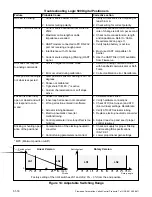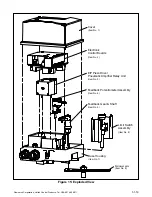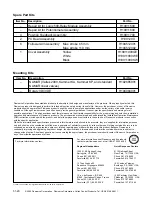
51-11
Flowserve Corporation, Valtek Control Products, Tel. USA 801 489 8611
is for future enchancements. There is also a rotary
selector switch for adjusting the positioner gain settings.
For indication of operational status or alarm conditions
there are also three LEDs on the local user interface.
Initial DIP Switch Setting
Before placing the unit in service, set the DIP switches
in the
Configuration and Cal boxes to the desired con-
trol options.
NOTE: The switch settings in the Configuration box are
activated only by pressing the Quick-Cal button or by
utilizing the stroke calibration features provided by a
handheld or by Flowserve PC software.
Operation of Configuration DIP Switches Setup
The first six DIP switches are for basic configuration
1. Air Action – Must be set to match the configuration
of the valve/actuator mechanical configuration.
ATO
(air-to-open) – Selecting ATO if increasing
output pressure from the positioner is tubed so it will
cause the valve to open.
ATC (air-to-close) – Selecting ATC if increasing
output pressure from the positioner is tubed so it will
cause the valve to close.
2. Signal at Closed – Normally this will be set to 4 mA
for an air-to-open actuator, and 20 mA for an air-to-
close actuator configuration.
Selecting 4 mA will make the valve fully closed
when the signal is 4ma and fully open when the
signal is 20 mA.
Selecting 20 mA will make the valve fully closed
when the signal is 20 mA and fully open when the
signal is 4 mA.
3. Pos. Characterization
Select
Linear if the actuator position should be
directly proportional to the input signal.
Select
Optional if another characteristic is desired,
which is set in conjunction with the next switch,
labeled
Optional Pos. Char.
4. Optional Pos. Char. – If the
Pos. Characterization
switch is set to optional, this switch is active with the
following options:
The
=% option will characterize the actuator
response to the input signal based on a standard
30:1 equal percent rangability curve.
If
Custom is selected, the positioner will be charac-
terized to a custom table that must be set-up using
a properly configured HART 275 handheld or other
host software.
5. Auto Tune – This switch controls whether the
positioner will auto tune itself every time the
Quick-Cal button is pressed
On enables an auto tune feature that will automati-
cally determine the positioner gain settings every
Figure 10: Logix 500 Local Interface
Enhanced
Quick-Cal
Configuration
Switches
Autotune
Lockout
Switch
4-20 mA input
with HART
Communications
Terminals for Optional Limit Switches
Quick-Cal Button
Gain Selector
Jog Calibrate
Buttons
LED Status
Lights




















